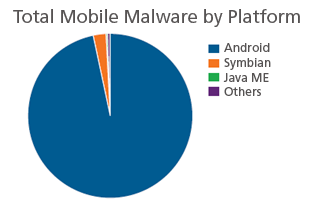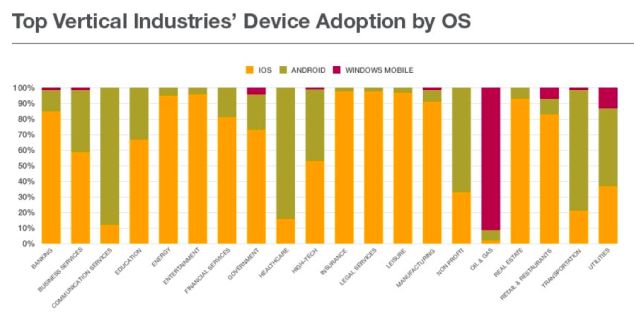A pair of reports issued yesterday really put the growth of mobile in perspective. Currently, the mobile landscape is dominated by two players – Apple’s iOS and Google’s Android.
While Apple is increasingly favored by companies big and small, Android has become the go-to vector for mobile malware, it seems.
Attacks involving mobile devices has risen dramatically in the space of just one year, skyrocketing to more than 36,000 instances in 2012, up from only 792 cases, according to a security research firm.
Meanwhile, large companies are adopting Apple devices at a faster clip than Android, according to another report…
“The growth of mobile malware shows no sign of slowing and this threat will likely continue to explode as mobile devices remain particularly attractive to cybercriminals and malware authors,” according to a blog post for security firm McAfee.
Among the attractions of mobile for malware creators: the easy access to address books and passwords, as well as smartphones ability for Trojan software to send SMS messages unwittingly enrolling users in lucrative premium services.
What’s more, Android devices make for the bulk of mobile devices infected by malware, according to the Intel-owned McAfee.
Among the many Android exploits are ones that disguise malware as antivirus apps.
The malware then uploads personal data to an attacker’s server, opening a door for remote control of the mobile device. Other malware detected by McAfee include ones that gain root access to your phone or fakes your financial institution into revealing banking data, according to the security firm.
Also showing the growth of mobile is the continued acceptance of Apple devices in enterprises.
A Centrix System report found 58 percent of enterprises around the world were allowing workers to use Apple devices during the fourth quarter of 2012.
The number indicated a two percent gain for Apple over the previous three months. Android was used by 35 percent of enterprises, falling two points. Microsoft mobile devices were used in just seven percent of enterprises, according to the report published by Fortune.
North America and Asia were strongholds for iOS, reporting 62 percent and 75 percent enterprise adoption. Citrix found support for Apple dropping in Europe, the Middle East and Africa, where penetration slipped to 43 percent from 56 percent.
By contrast, Android saw adoption grow to 36 percent in the same areas for an eleven-point advance.
Finally, an intriguing chart by Citrix shows what industries favor iOS, Android or Windows Mobile. As Fortune’s Philip Elmer-DeWitt points out, iOS is favored in areas where personal contact is premium – such as retail, restaurants, and real estate.
Android is picked more often for utilities, health care and communications.
But is it a great idea for businesses overseeing such key infrastructure to be using devices ripe for malware as their preferred mobile platform?


